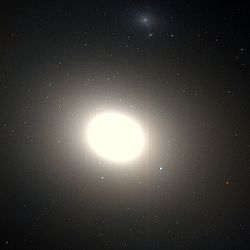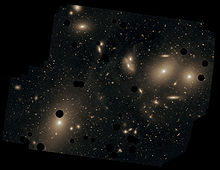- Messier 86
-
Messier 86 
M86 by Hubble Space TelescopeObservation data (J2000 epoch) Constellation Virgo Right ascension 12h 26m 11.7s[1] Declination +12° 56′ 46″[1] Redshift -0.000814 +/- 0.000017 (-244 ± 5 km/s)[1] Distance 52 ± 3 Mly (15.9 ± 1.0 Mpc)[2] Type S0(3)/E3[1] Apparent dimensions (V) 8′.9 × 5′.8[1] Apparent magnitude (V) 9.8[1] Notable features displays a rare blue shift Other designations NGC 4406,[1] UGC 7532,[1] PGC 40653,[1] VCC 0881[1] See also: Galaxy, List of galaxies Messier 86 (also known as M86 or NGC 4406) is a lenticular galaxy in the constellation Virgo. It was discovered by Charles Messier in 1781. M86 lies in the heart of the Virgo Cluster of galaxies and forms a most conspicuous group with another giant, Lenticular Galaxy M84. It displays the highest blue shift of all Messier objects, as it is approaching the Milky Way at 244 km/s. This is due to its falling towards the center of the Virgo cluster from the opposite side, which causes it to move in the direction of the Milky Way.[3]
References
- ^ a b c d e f g h i j "NASA/IPAC Extragalactic Database". Results for NGC 4406. http://nedwww.ipac.caltech.edu/. Retrieved 2006-11-14.
- ^ Jensen, Joseph B.; Tonry, John L.; Barris, Brian J.; Thompson, Rodger I.; Liu, Michael C.; Rieke, Marcia J.; Ajhar, Edward A.; Blakeslee, John P. (2003). "Measuring Distances and Probing the Unresolved Stellar Populations of Galaxies Using Infrared Surface Brightness Fluctuations". Astrophysical Journal 583 (2): 712–726. arXiv:astro-ph/0210129. Bibcode 2003ApJ...583..712J. doi:10.1086/345430.
- ^ Jacoby, G. H.; Kenney, J. D. P.; Tal, T.; Crowl, H. H.; Feldmeier, J. J.; Kenney; Tal; Crowl; Feldmeier (2005). "Imaging and Spectroscopy of Large Scale H-alpha Filaments in M86". Bulletin of the American Astronomical Society 37: 1392. Bibcode 2005AAS...20713806J.
External links
- SEDS Lenticular Galaxy M86
- Messier 86 on WikiSky: DSS2, SDSS, GALEX, IRAS, Hydrogen α, X-Ray, Astrophoto, Sky Map, Articles and images
Virgo constellation Stars Bayer α (Spica) • β (Zavijava) • γ (Porrima) • δ (Auva) • ε (Vindemiatrix) • ζ (Heze) • η (Zaniah) • θ • ι (Syrma) • κ • λ (Khambalia) • μ (Rijl al Awwa) • ν • ξ • ο • π • ρ • σ • τ • υ • φ • χ • ψ • ω • b • c • d¹ • d² • e • f • g • h • i • k • l • m • o • p • q • y • A¹ • A² • MFlamsteed 1 (ω) • 2 (ξ) • 3 (ν) • 4 (A¹) • 5 (β, Zavijava) • 6 (A²) • 7 (b) • 8 (π) • 9 (ο) • 10 • 11 • 12 • 13 • 15 (η, Zaniah) • 16 (c) • 17 • 20 • 21 (q) • 25 (f) • 26 (χ) • 27 • 28 • 29 (γ, Porrima) • 30 (ρ) • 31 (d¹) • 32 (d²) • 33 • 34 • 35 • 37 • 38 • 40 (ψ) • 41 • 43 (δ, Auva) • 44 • 46 • 47 (ε, Vindemiatrix) • 48 • 49 • 50 • 51 (θ) • 53 • 54 • 55 • 56 • 57 • 59 (e) • 60 (σ) • 61 • 62 • 63 • 64 • 65 • 66 • 67 (α, Spica) • 68 (i) • 69 • 70 • 71 • 72 • 73 • ) • 75 • 76 (h) • 77 • ) • 79 (ζ, Heze) • 80 • 82 (m) • 83 • 84 • 85 • 86 • 87 • 89 • 90 (p) • 92 • 93 (τ) • 94 • 95 • 96 • 98 (κ) • 99 (ι, Syrma) • 100 (λ, Khambalia) • 102 (υ) • 104 • 105 (φ) • 106 • 107 (μ, Rijl al Awwa) • 108 • 109 • 110 • 2 SerNearby Ross 128 • Wolf 424 • FL (Wolf 424 B) • GL • Gliese 514 • Gliese 493.1 • Gliese 518 • Gliese 486 • GJ 1154 • 61 • GJ 3820List Galaxy cluster Coordinates:
 12h 26m 11.7s, +12° 56′ 46″
12h 26m 11.7s, +12° 56′ 46″Messier objects List M1 · M2 · M3 · M4 · M5 · M6 · M7 · M8 · M9 · M10 · M11 · M12 · M13 · M14 · M15 · M16 · M17 · M18 · M19 · M20 · M21 · M22 · M23 · M24 · M25 · M26 · M27 · M28 · M29 · M30 · M31 · M32 · M33 · M34 · M35 · M36 · M37 · M38 · M39 · M40 · M41 · M42 · M43 · M44 · M45 · M46 · M47 · M48 · M49 · M50 · M51 · M52 · M53 · M54 · M55 · M56 · M57 · M58 · M59 · M60 · M61 · M62 · M63 · M64 · M65 · M66 · M67 · M68 · M69 · M70 · M71 · M72 · M73 · M74 · M75 · M76 · M77 · M78 · M79 · M80 · M81 · M82 · M83 · M84 · M85 · M86 · M87 · M88 · M89 · M90 · M91 · M92 · M93 · M94 · M95 · M96 · M97 · M98 · M99 · M100 · M101 · M102 · M103 · M104 · M105 · M106 · M107 · M108 · M109 · M110See also  Book:Messier objects ·
Book:Messier objects ·  Category:Messier objects
Category:Messier objects  Portal:AstronomyCategories:
Portal:AstronomyCategories:- Lenticular galaxies
- Virgo Cluster
- Virgo constellation
- Messier objects
- NGC objects
- UGC objects
- PGC objects
Wikimedia Foundation. 2010.


